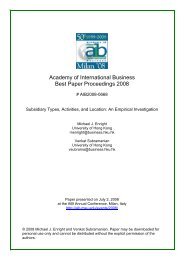AIB 2012 Conference Proceedings - Academy of International ...
AIB 2012 Conference Proceedings - Academy of International ...
AIB 2012 Conference Proceedings - Academy of International ...
Create successful ePaper yourself
Turn your PDF publications into a flip-book with our unique Google optimized e-Paper software.
SUNDAY<br />
effects among scale and scope attributes <strong>of</strong> patent portfolio. The results show that patent scale generates<br />
stronger direct effects than patent scope; contrastingly patent scope requires mediators to impact performance,<br />
but rarely demonstrates any effect in the patenting-sample. In addition, our findings on stronger performance<br />
effects <strong>of</strong> the full-sample than the patenting-sample imply that patenting may not sustain performance impacts<br />
among active innovators. Such a contingent view <strong>of</strong> innovation strategy may contribute to specify the applicable<br />
conditions for a firm to enhance its competitive advantage via strategic fitness between multiple patenting<br />
strategies and performance targets. (For more information, please contact: Sonya H. Wen, Tamkang University,<br />
Taiwan: sonya.wen@gmail.com)<br />
Breeding the Competition How Innovation Performance Varies across Partnerships between Foreign and Local<br />
Firms in China<br />
Simon C. Collinson, Reading University<br />
Kamel Mellahi, University <strong>of</strong> Warwick<br />
Cherif Guermat, University <strong>of</strong> the West <strong>of</strong> England<br />
Our central premise in this paper is that the level <strong>of</strong> knowledge transfer and resulting innovation performance in<br />
partnerships between MNCs and foreign subsidiaries are pr<strong>of</strong>oundly linked to the type <strong>of</strong> the partnership. We<br />
compare changes in innovation outputs from competitive and cooperative partnerships established by foreign<br />
multinational firms in China. Our strongest finding is that output innovation, measured by both the quality and<br />
reliability <strong>of</strong> products and the range <strong>of</strong> products and services produced by the partnership, is positively and<br />
significantly related to competitive partnerships. Some kinds <strong>of</strong> process innovation are also improved by<br />
competitive partnerships. Cooperative partnerships by way <strong>of</strong> contrast are negatively associated with both<br />
product and process innovation. Moreover, we find a strong link between long-term partnerships and superior<br />
performance in process innovation outputs. This suggests that particular kinds <strong>of</strong> resource relatedness and<br />
"combinational potential" underlie particular kinds <strong>of</strong> innovative outputs in international partnerships. (For more<br />
information, please contact: Simon C. Collinson, Reading University, United Kingdom:<br />
s.collinson@reading.ac.uk)<br />
How Does a Child Teach Herself and Her Parent Subsidiary Technology Acquisition from Multiple Sources and<br />
MNC Performance<br />
Akie Iriyama, State University <strong>of</strong> New York at Buffalo<br />
Sean Tsuhsiang Hsu, University <strong>of</strong> Pittsburgh<br />
This study seeks to address two related gaps in the literature on the subsidiary's role in the development <strong>of</strong><br />
MNC technological competence. First, whereas previous studies suggest subsidiary technology acquisitions from<br />
different sources influence subsidiary technology performance, few empirical efforts are made to test this in an<br />
integrated empirical framework. Second, there are no studies to examine whether a subsidiary's technology<br />
acquisitions from multiple sources contribute to the technology performance <strong>of</strong> its home country headquarters.<br />
Using the unique survey data compiled by Taiwan's government, we construct a panel dataset <strong>of</strong> 1,971<br />
Taiwanese MNCs during the period between 2003 and 2006, and we examine the impact <strong>of</strong> nine technology<br />
acquisition sources <strong>of</strong> MNC subsidiaries on technology performance <strong>of</strong> the subsidiaries and their headquarters.<br />
We reveal that Taiwanese MNC subsidiaries mainly rely on three out <strong>of</strong> the nine technology sources, i.e. (1)<br />
headquarters, (2) its own local R&D activity, and (3) inter-firm collaboration. Regressions suggest that all <strong>of</strong> the<br />
three channels have a positive impact on subsidiary technology performance. We also find that the effects are<br />
contingent on subsidiary governance structure and experience in the host country. Finally, we find that<br />
subsidiary technology acquisition from its local R&D activity contributes to its headquarters technology<br />
performance. Overall, the results suggest that subsidiary technology acquisitions contribute to MNC technology<br />
performance for limited types <strong>of</strong> sources and under limited conditions. The study complements the literature <strong>of</strong><br />
MNC competence creation by showing comprehensive evidence <strong>of</strong> the role <strong>of</strong> subsidiaries in technology<br />
acquisitions. It also has an implication for managers that they should consider the important role <strong>of</strong> local R&D<br />
<strong>AIB</strong> <strong>2012</strong> <strong>Conference</strong> <strong>Proceedings</strong><br />
Page 50

















